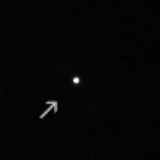
2685 Masursky
Encyclopedia
The asteroid 2685 Masursky is a main-belt
asteroid
. It was discovered by Edward (Ted) Bowell
in 1981. It was named after Harold Masursky
(1923–1990), a planetary geologist at the U.S. Geological Survey, Flagstaff
, who worked on numerous space missions.
Little was known about Masursky until the Cassini space probe
, en route to Jupiter
and Saturn
, flew past it on 23 January 2000. Since Cassini passed the asteroid at a distance of 1.6 million kilometres (about four times the Earth
–Moon
distance), the images it returned showed nothing more than a dot. Nevertheless, Cassini was able to determine Masursky's size (about 15–20 km in diameter).
Masursky's orbit places it within the Eunomia family
of S-type asteroid
s. Cassini's observations had cast some doubt on its composition, but later ground-based spectroscopy has confirmed its S-type spectrum.[2]
Asteroid belt
The asteroid belt is the region of the Solar System located roughly between the orbits of the planets Mars and Jupiter. It is occupied by numerous irregularly shaped bodies called asteroids or minor planets...
asteroid
Asteroid
Asteroids are a class of small Solar System bodies in orbit around the Sun. They have also been called planetoids, especially the larger ones...
. It was discovered by Edward (Ted) Bowell
Edward L. G. Bowell
Edward L. G. Bowell , known as "Ted", is an American astronomer. Bowell was educated at Emanuel School London, University College, London, and the Université de Paris....
in 1981. It was named after Harold Masursky
Harold Masursky
Harold Masursky was an American geologist and astronomer.He started his career working for the US Geological Survey and later joined NASA as a senior science member. He was responsible for investigation of planetary and lunar surfaces, being interested in finding scientifically valuable landing...
(1923–1990), a planetary geologist at the U.S. Geological Survey, Flagstaff
Flagstaff, Arizona
Flagstaff is a city located in northern Arizona, in the southwestern United States. In 2010, the city's population was 65,870. The population of the Metropolitan Statistical Area was at 134,421 in 2010. It is the county seat of Coconino County...
, who worked on numerous space missions.
Little was known about Masursky until the Cassini space probe
Cassini-Huygens
Cassini–Huygens is a joint NASA/ESA/ASI spacecraft mission studying the planet Saturn and its many natural satellites since 2004. Launched in 1997 after nearly two decades of gestation, it includes a Saturn orbiter and an atmospheric probe/lander for the moon Titan, although it has also returned...
, en route to Jupiter
Jupiter
Jupiter is the fifth planet from the Sun and the largest planet within the Solar System. It is a gas giant with mass one-thousandth that of the Sun but is two and a half times the mass of all the other planets in our Solar System combined. Jupiter is classified as a gas giant along with Saturn,...
and Saturn
Saturn
Saturn is the sixth planet from the Sun and the second largest planet in the Solar System, after Jupiter. Saturn is named after the Roman god Saturn, equated to the Greek Cronus , the Babylonian Ninurta and the Hindu Shani. Saturn's astronomical symbol represents the Roman god's sickle.Saturn,...
, flew past it on 23 January 2000. Since Cassini passed the asteroid at a distance of 1.6 million kilometres (about four times the Earth
Earth
Earth is the third planet from the Sun, and the densest and fifth-largest of the eight planets in the Solar System. It is also the largest of the Solar System's four terrestrial planets...
–Moon
Moon
The Moon is Earth's only known natural satellite,There are a number of near-Earth asteroids including 3753 Cruithne that are co-orbital with Earth: their orbits bring them close to Earth for periods of time but then alter in the long term . These are quasi-satellites and not true moons. For more...
distance), the images it returned showed nothing more than a dot. Nevertheless, Cassini was able to determine Masursky's size (about 15–20 km in diameter).
Masursky's orbit places it within the Eunomia family
Eunomia family
The Eunomia family of asteroids is a large grouping of S-type asteroids named after the Greek goddess Eunomia. It is the most prominent family in the intermediate main belt...
of S-type asteroid
S-type asteroid
S-type asteroids are of a stony composition, hence the name. Approximately 17% of asteroids are of this type, making it the second most common after the C-type.-Characteristics:...
s. Cassini's observations had cast some doubt on its composition, but later ground-based spectroscopy has confirmed its S-type spectrum.[2]

